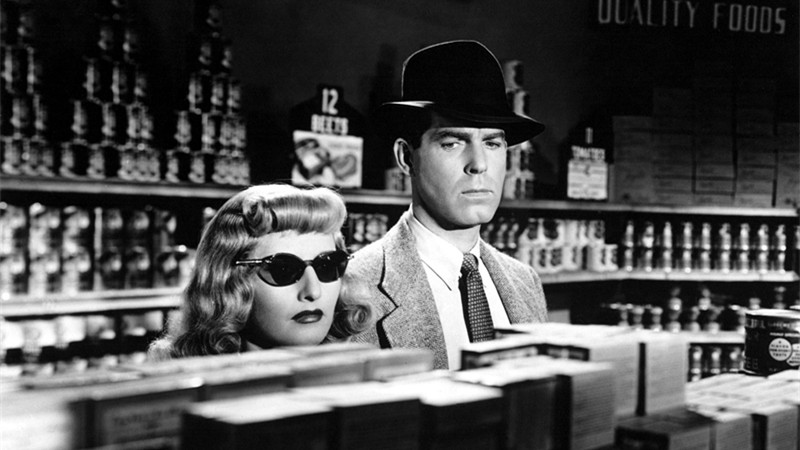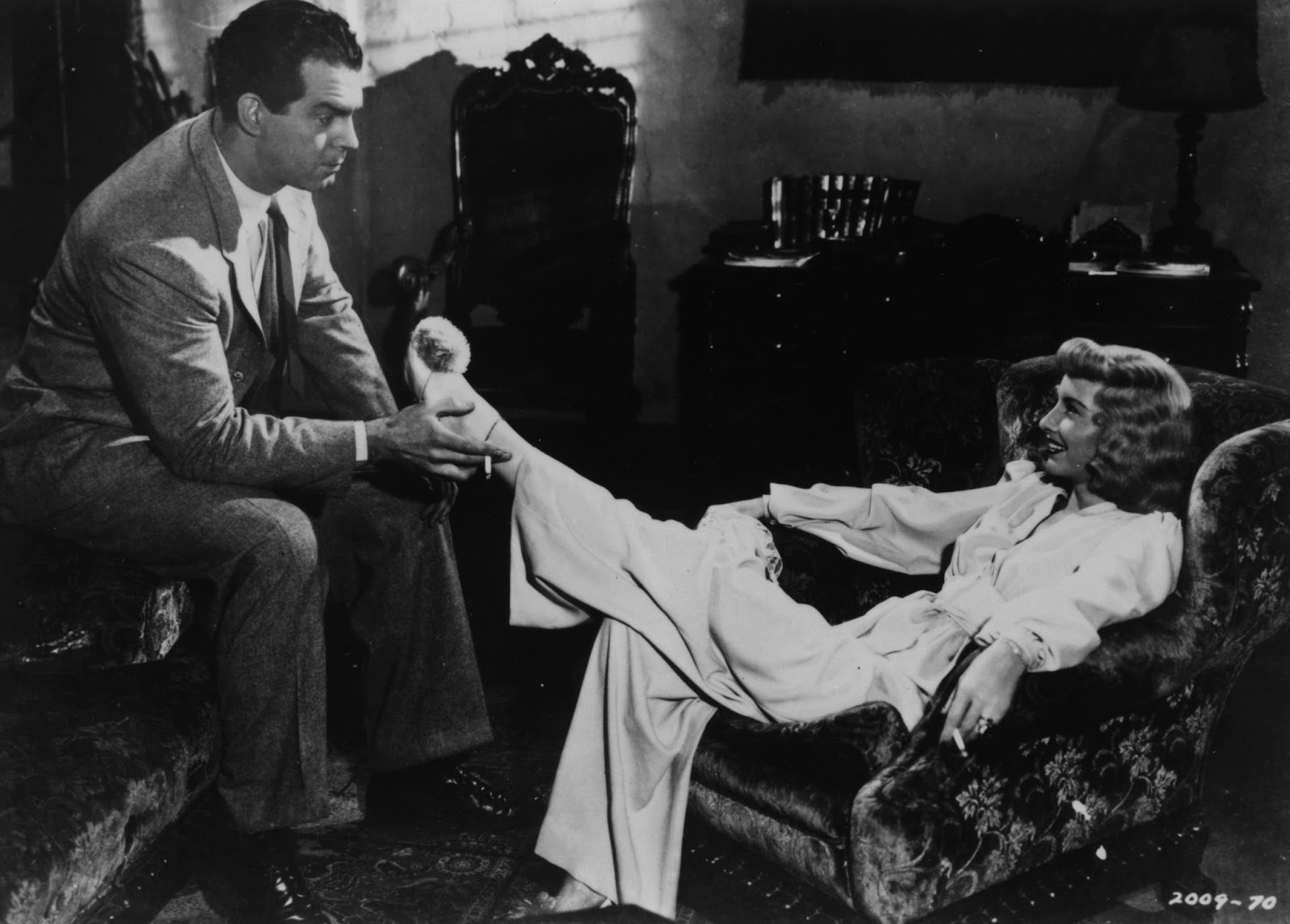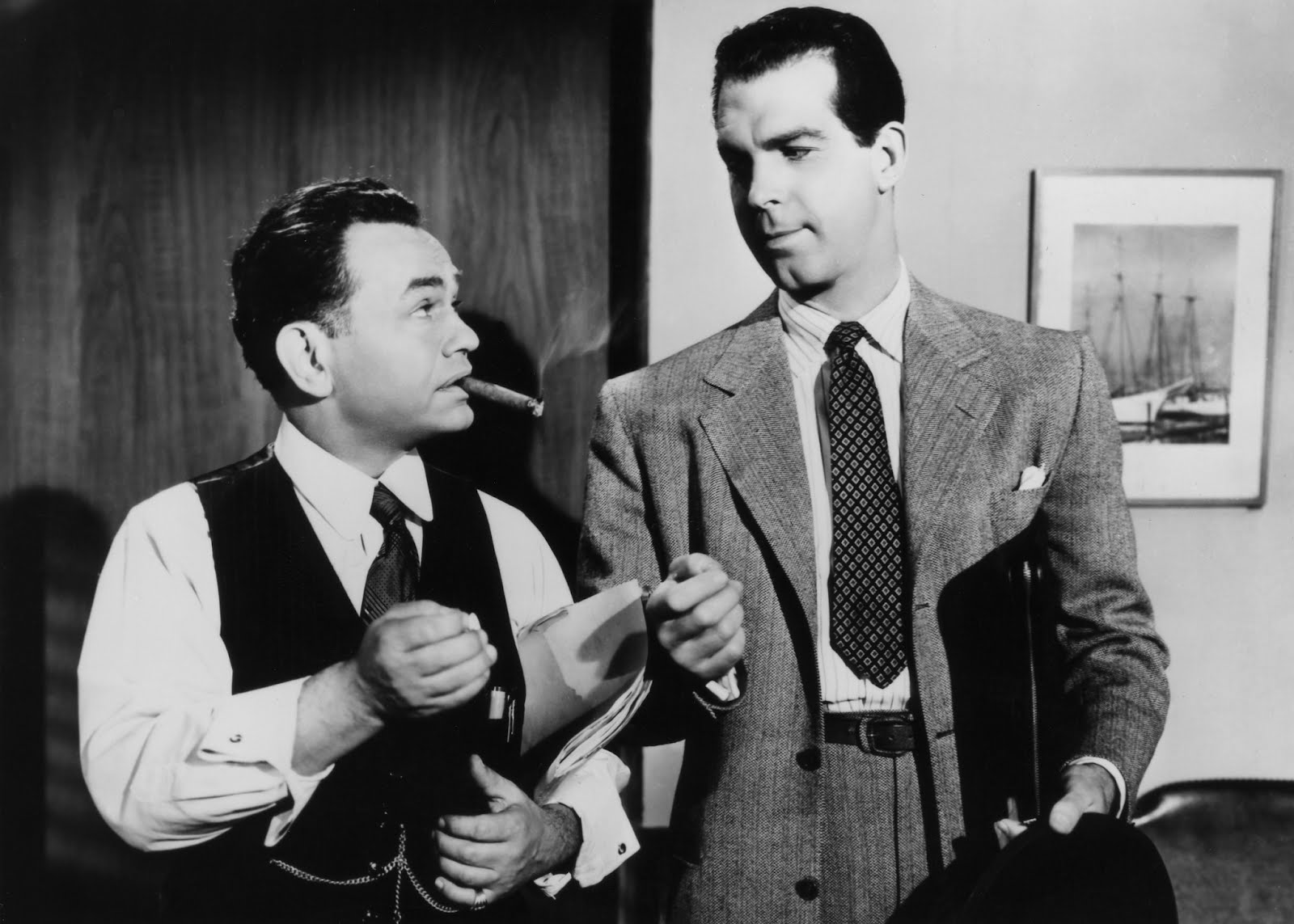
“Office memorandum, Walter Neff to Barton Keyes, Claims Manager. Los Angeles, July 16th, 1938. Dear Keyes: I suppose you’ll call this a confession when you hear it. I don’t like the word confession. I just want to set you right about one thing you couldn’t see, because it was smack up against your nose.”
“You think you’re such a hot potato as a claims manager, such a wolf on a phoney claim. Well, maybe you are, Keyes, but let’s take a look at this Dietrichson claim, Accident and Double Indemnity. You were pretty good in there for a while, all right. You said it wasn’t an accident. Check. You said it wasn’t suicide. Check. You said it was murder. Check and double check. You thought you had it cold, all wrapped up in tissue paper, with pink ribbons around it. It was perfect, except that it wasn’t, because you made a mistake, just one tiny little mistake. When it came to picking the killer, you picked the wrong guy, if you know what I mean. Want to know who killed Dietrichson?”
“Hold tight to that cheap cigar of yours, Keyes. I killed Dietrichson. Me, Walter Neff, insurance agent, 35 years old, unmarried, no visible scars. Until a little while ago, that is. Yes, I killed him. I killed him for money, and a woman, and I didn’t get the money and I didn’t get the woman. Pretty, isn’t it?”
– Walter Neff in “Double Indemnity”
Most critics declare Film Noir as a Hollywood sub-genre that had its golden age during the period ranging from the end of the 1930s to the 1950s. So, the natural question is: Why is a film produced in 1944 the sub-genre’s epitome when before that many supposedly noir films had been produced? There are two answers to this question.
First one that relies on the origins of Film Noir and in second place another that relies on the reasons that justify the importance of “Double Indemnity” and why it deserves to be called a Film Noir landmark.
Within the roots of Film Noir one can find “German Expressionism and horror, American gangster films of the thirties, Sternbergian exoticism and decadence, the poetic realism of Carné and Duvivier, the hard-boiled tradition of American fiction, the forties popularization of Freud, post-war American disillusionment (…) and the wave of cinematic realism it engendered, cold war paranoia, and of course, Citizen Kane”.
These were films that, similarly to the 50s melodramas, depicted the hidden depravity and horrors of American society, as well as, its lack of morale, values and sins – lust, greed, lack of sentiment or cruelty. As in Greek theatre, there is an idea in Film Noir of the inevitability of faith and that sooner or later man will meet his faith and whatever that might bring him.
These were films usually set in great cities such as Los Angeles or New York which served as bridges between the wildest of dreams and the crudest of realities (It’s not a coincidence that people call Los Angeles the city of broken dreams).
City landscape was then the stage for the unlikely protagonists – anti-heroic men, often connected with the crime business either as crime moguls, petty criminals or law enforcement agents (policemen, private detectives, lawyers); femme fatales (highly seductive women with an apparent lack of morality); and femme fragiles (marginalized women, victims of circumstance or brutal realities).
Film Noir, should be regarded as a post-war tendency that had its predecessors before the war with gangster films – such as 1931’s “The Public Enemy” directed by William A. Wellman and starring James Cagney or 1932’s “Scarface” directed by Howard Hawks and starring Paul Muni – and other major crime dramas such as “Stranger on the Third Floor” (1940), “The Maltese Falcon” (1941), “This Gun for Hire” (1942) or Raoul Wahl’s “High Sierra” (1943).
In fact, Film Noir is a genre within the cinema of disillusionment and the two great keys to understand the importance of this Hollywood sub-genre are darkness and cynicism. With this statement, we begin to understand one of the reasons why “Double Indemnity” is regarded so highly and is considered the sub-genre’s prototype.
1. Its cold-blooded realism

As stated in a previous article, about the importance of “Double Indemnity”: “it introduces audiences for the first time to a really adult scenario that was too “avant-garde” for the promiscuous sensors of American cinema throughout this period. It depicts visually and psychologically the power of sensuality, sex, hypocrisy and some other qualities existent in a given adult ‘forbidden’ relationship.”
In fact, when talking about realism in “Double Indemnity” we have to understand that it comes from two sources. Following this line of thinking, the first to mention is visual realism which was achieved through the conception of a plot centred on real life and real people and shot on location throughout many different Los Angeles’ areas.
Also important is that the shooting of night scenes really occur at night rather than during daylight using dark filters as it was done within the studios. In “Double Indemnity” there is the breaking of some of the ideas from the studio system’s conception of “invisible film” by creating harsh contrasts between light and dark, as well as, adopting peculiar compositions and points of view.
However, the ‘real realism’ that marks the difference in “Double Indemnity” comes from the exploration of a set of different immaterial ideas and psychological elements.
Only before the pre-code era had audiences seen such a truthful depiction of human relationships, particularly that between two adults simultaneously interested in one another. And the reason why we shan’t call Walter and Phyllis lovers is because it is quite clear that none of them is in love with the other. Indeed, it becomes quite apparent from the first time they meet that whatever relationship will come out of there it is condemned to a not so happy ending.
From this first moment, Billy Wilder’s mastery, introduces us a woman who is only interested in that man because of what he can do for her, he is a mean to achieve her well-being, which of course is the gorgeous sum of insurance money. This is Phyllis Dietrichson, the femme fatale. And the man, the insurance agent, is the bachelor who upon seeing that woman falls under her spell and succumbs to his own desire. A desire of carnal nature. This is Walter Neff, the anti-heroic insurance agent.
From these two figures of middle class society we can take character realism, or, the type of realism taken from character and character persona.
Another source of realism is the thematically related realism. And within this context, the two main elements to write about are greed and sex.
Phyllis is clearly a woman who knows her place in the world. Of her background, we know nothing about but it isn’t too hard to guess, perhaps an obscure family drama caused for her to run or the urge to search for better opportunities in a big city or perhaps even she learned the ins and outs of the big city by growing up in its slums.
Whatever it was, her present motive is quite clear: greed. And her intentions: murder (not committed by her but by a third party who she can manipulate). She is the symbol of human greed and her depiction as the woman who is the source of evil and corruption is also something that noir films brought more intensely to the screen than their past ancestors (Mae West, Jean Harlow at some extent Bette Davis even though there were never so crudely and wide open depicted as such).
This was a major cut with the past image of the fragile, docile woman which is at some extent maintained with the figure of the femme fragile which is also typical of films noir but isn’t featured in “Double Indemnity”, perhaps because there really aren’t people like that.
The lesson here is that “Double Indemnity” showed us the depth of the self. Women, like men, like all human beings aren’t entirely good or bad, they have a somewhat disputed nature which can either bend towards the ‘right side’ (morality) or ‘wrong side’ (basic human needs).
And this also makes sense when it comes to the figure of Walter Neff. Neff is a bachelor and the presence of this somewhat mysterious woman compels him to follow his need of wanting her. From the beginning Neff knows what are the real intentions of Phyllis and, perhaps, he might even know that he is nothing but a pawn in her game.
Thus, Walter Neff serves as a symbol of human desire. He is the icon of every man and every woman who consciously or unconsciously reach for the forbidden fruit and sooner or later taste the bitterness of that experience.
However, what helps to highlight this atmosphere of tension between the two is of course the sexualisation of the woman figure that is explored in dialogue, directing, costume and art direction, as well as, acting (in fact, the role of Phyllis scared Barbara Stanwyck so much that she declined it at first because she was afraid the image produced by Phyllis could hurt her career, of course, Wilder convinced her otherwise).
From a different point of view, another type of realism can be perceived in “Double Indemnity”, the one driven out of type characters or “type realism” (the term is a personal invention). Type characters are those that in literature serve as symbols of something for instance as the choir in Greek Theatre serves as the voice of faith.
In “Double Indemnity”, the type realism is taken not so much from a specific character but from the character’s activities (for living I mean) and another character’s speech. In Barton Keyes’ speech (Edward G. Robinson), he conceives the insurance company as a sort of symbol for this modern hypocrisy in society and in man to man relations.
“I know you did, Walter. I’m not beefing at you. It’s the company. The way they do things. The way they don’t do things. The way they’ll write anything just to get it down on the sales sheet. And I’m the guy that has to sit here up to my neck in phony claims so they won’t throw more money out of the window than they take in at the door. (…) I get darn sick of picking up after a gang of fast-talking salesmen dumb enough to sell life insurance to a guy that sleeps in the same bed with four rattlesnakes. I’ve had twenty-six years of that, Walter, and I…”.
At last, connected with this psychological realism is the tone chosen to narrate it – cynicism. Of which many examples have been given in this article up to this point.
2. Its contributions to storytelling and scriptwriting and how it helped establishing Film Noir conventions

Exceptionally well written, “Double Indemnity” applies Billy Wilder’s cynicism to the rules of one of the household names when it comes to hard boiled literature, Dashiell Hammett.
Hammett, who was a leading figure in the golden age of detective novels during the 1920s and 1930s, wrote a number of “Suggestions to Detective Story Writers” which can be read in “Hammett: Crime Stories and other writings”. While reading, some of these sure reason a number of storytelling aspects introduced in “Double Indemnity”.
First as Chandler puts it: the story must be credibly motivated (up to this point Phyllis and Walter’s motives have been discussed). Second, it must use elements or refer to the methods of murder and detection (this is done by starting the film in the present, therefore, arousing the audience’s curiosity and from then on following a series of flashbacks and the incredibly disillusioned narration from Walter Neff). The third aspect referred by Chandler is that the story must be realistic in setting, atmosphere and character.
The fourth aspect is to appeal to the adventure side of the story, meaning, making the circumstances of such a crime thrilling and from this point of view the audience is presented with the murder plot in the film’s first half hour which naturally makes exciting the idea of knowing how they did it.
Another ‘commandment’ is that the story must be simple and explained easily because it is the structure that should induce the most intelligent of readers to error and confusion not so much the explanation.
And at this point, we reach a conclusion – we, the audience, are Barton Keyes. And even though we already know who the guilty parties are, we have yet to figure out how they did it. And when we’ve figure out how they did it we have yet to come to terms with the unfolding of the guilty parties’ faith.
Other crucial elements that the writer points out is that the solution should be inevitable once it is exposed (no need for exemplification) and that whenever possible the story should not mixture tones and moods, for instance, if it depicts a passionate romance it can’t suddenly change into a casual atmosphere because once the pace of a given scene is set one should be extremely careful when trying to change it (to add more information or intricate secrets).
Another golden rule and this is clearly featured in “Double Indemnity” is that the criminal must be punished and this does not imply that the law has to be involved. He or she should meet their punishment ‘one way or the other’. Finally, the tenth important rule is that the story must be truthful with its reader. So, the question is, does anyone feel deceived by “Double Indemnity”?
With all that being said, the conclusion to infer is that “Double Indemnity” not only helped to establish a number of thematically and formal Film Noir conventions, but also made of Walter Neff and Phyllis Dietrichson role models for the sub-genre’s characters.